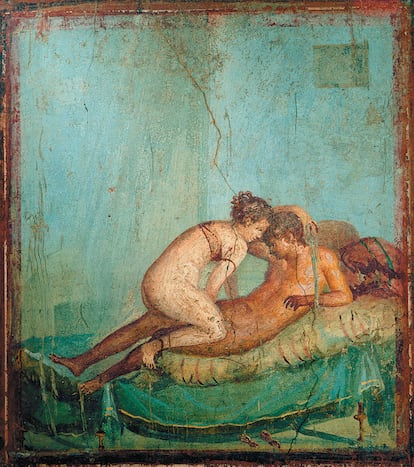Sex in Ancient Rome: a violent approach to lovemaking
Historian Patricia González Gutiérrez, author of ‘Cunnus,’ explains that the concept of consent was alien to Romans


In ancient Rome, a woman on top during sexual intercourse was frowned upon. Given the suggestion that the man was being ridden like a horse, it was considered humiliating for the male partner. It was a position specific to prostitutes and carried with it a higher fee — up to twice as much in Pompeii — as it was considered somewhat kinky. However, the woman having intercourse on all fours was acceptable, because the Romans respected the natural world and animals, and this position seemed to favor fertility.
The buttocks were appreciated more than breasts: large breasts were the object of ridicule — the adjective mastale, meaning busty, was used — as were large penises. Another thing that would surprise us about Roman habits in bed, or in the dining room or at the kitchen table, is a resounding rejection of oral sex, and especially cunnilingus, which comes from the Latin cunnus, meaning vulva, and lingere, to lick.
Cunnus is the word historian Patricia González Gutiérrez has chosen as the title for her new book, which is subtitled Sex and power in Rome. Once again focusing on gender issues like her previous work, Soror, Women in Rome (2021), the cover of Cunnus is an explicit illustration of the female genitalia by Paula Bonet. “Well, there are people who understand right away what it is and others who don’t, so we decided to go all out,” explains González, a 40-year-old scholar who was born in Santiago de Chile to Spanish parents. From a table in a Barcelona cafeteria, she goes on to point out the difficulty of addressing the subject of sex in history beyond unscientific dissemination and anecdotes. “It is a topic that continues to be controversial when it is dealt with from an academic point of view; the motives for doing so are questioned with activism suspected.”
How did the ancient Romans do it? “Very differently and very much like us at the same time,” answers González, who is not unlike the British classics media personality Mary Beard regarding her rebellious attitude and her ability to tackle provocative topics. “Their concept of sex was conditioned by that of hierarchy, rather than gender. If you were powerful, you could do whatever you wanted. In general, almost anything was permissible as long as you were a man and the active partner in the relationship, with women and inferior men, such as gladiators and actors of both sexes, always being penetrated by you.” The vir, the man of virtue, the Roman patrician, was literally impenetrable. It is possible that the Emperor Nero characterized his male lovers as girls to avoid speculation on this issue rather than for esthetic reasons. “Of course, slaves were completely subjected and at the sexual mercy of the owner at all times, even children,” she says.
In theory there were some boundaries — other citizens were off limits, for example. And statutory rape of young boys and girls of good family as well as adultery were crimes, although the one considered at fault was invariably the woman. “Gender violence was the order of the day, and any real chance of justice was slim,” says González. “Killing a woman could prove terribly cheap.”
Oral sex, according to González, was not socially acceptable. It was seen as humiliating for the one who practiced it — they would be considered impudicitia meaning sexually impure; it was thought that it dirtied the mouth. The poet Martial added that it produced bad breath. This does not mean that it did not happen, especially fellatio, but “there are few allusions and representations, and even less of cunnilingus, which was more vilified.” In fact, when it comes to graffiti, one usually finds the expression lingitcunnum — a person who performs cunnilingus used as an insult. Anal sex was highly reprehensible and humiliating and dishonorable if you were the passive partner, but, says González, we have plenty of evidence of it, from the Warren Cup to the explicit poems of Martial and the Priapic inscriptions — “te pedico,” I give it to you up the ass, was the war cry of the god.

The ancient Romans were well aware of the female orgasm and the clitoris, which they called the landica, and there are even medical sources that speak of manipulating it to eliminate hysteria; it was also ‘trimmed’ when it was considered too big, for medical reasons, never religious. In any case, “female pleasure must have been complicated when you’re first raped at the age of 10 and have your wedding night with mature men at 12,” as González points out. “When you look at sex in Rome, it is much harder to see elements of tenderness as opposed to those of humiliation, not unlike on today’s social networks.” González adds that it was common to associate the penis with the pilum or spear, and other weapons, which sums up the aggressive nature of male sexuality at the time.
Despite so many stories, movies and series revolving around Roman orgies and debauchery, González insists that the ancient Romans were “quite puritanical.” But what about the objects and paintings from Pompeii kept in the Secret Museum in Naples, what about Caligula, what about Messalina? “These are extreme cases,” she says. “In general, we have exaggerated the sexuality of the Romans. The reality is that even public displays of affection were frowned upon. Cato the Elder expelled a certain Manilius from the Senate for kissing his wife in broad daylight and in front of his daughter. Plutarch recommended avoiding marrying a woman who claimed to be in love with you, as the passion was unbecoming. We have been influenced by images from movies and series, such as I, Claudius, and Spartacus.” That is not to say that there weren’t people who escaped the norm — Seneca accused Mamercus Scaurus of receiving the menstrual blood of his female slaves with his mouth open, the epitome of everything repulsive to a Roman. Also, at the pinnacle of the elites, there were behaviors that make Tinto Brass look like an amateur: “What Tiberius did with children was even worse than what the movie Caligula depicted,” says González. “The children with whom the emperor bathed, his little fishes, were little ones who still had the suckling reflex and latched on.”

González points out that ancient Rome was a society that produced aqueducts, roads, laws, and great culture, but in which equally great violence was the order of the day: “Sexual violence was terrible,” she says. “We would not like to have lived in ancient Rome. There was absolutely no consent. What we talk so much about now with the Rubiales case was alien to them. They didn’t even have a word to describe it. The accepted status quo was one of women bending entirely to the will of men, and the humble to the powerful.” According to González, when we think of ancient Rome, what comes to mind is Messalina, Poppea and Julia, the daughter of Augustus, famous for her scandalous promiscuity, but the women who really embodied the daily reality of Rome were the raped Lucretias, or the Cornelias — serious, self-sacrificing women. Or Octavia, who shut up and put up. Or, “the much reviled Livia herself, who is married at 14, has two children before she is 18, is forced to divorce and ends up married to the sociopath, Augustus.”
González mentions the poet Ovid, and not exactly in praise of his poem, The Metamorphoses. “The poet of love, ha!” she says. “We have not read the sources properly. The art of loving is shocking. Not only because it is a list of tricks to deceive women, but because it directly advocates mistreatment and justifies it. He himself is shown to be a textbook abuser, who beat his girlfriend and then repented and gave her flowers. A horrible and idiotic character. Much worse than Rubiales. Today he would have been roasted on Twitter.”

It is true that, despite its literary beauty — Ovid’s poetry flowed instinctively: “quidquid tentabam dicere, versus erat,” — some chapters of the seduction manual, The Art of Love, are seriously appalling when read with today’s sensibility. Like the one entitled “More means of seduction: tears, kisses and, if necessary, violence.” In a translation by Juan Luis Arcaz Pozo, the poet writes: “Those she does not give you [kisses], you take from her. At first perhaps she will oppose you and say ‘indecent,’ but she will want to be defeated in the dispute. See only that the kisses thus stolen do not hurt her delicate lips and that she cannot complain that they were violent.”
And there’s worse: “Even if you appeal to violence, such violence is pleasing to girls,” Ovid writes. “Many times they wish to give unwillingly that which they like. Anyone who has been forced by a sudden rapture of passion is grateful for it and considers this indecency as a gift.”
Cultured and enlightened, Ovid, the poet of the city of Sulmona, justifies his advice with examples of mythology as unedifying as that of Achilles, who, when he was hiding in the court of the king of Scyros disguised as a woman to avoid going to Troy, got into the bed of the king’s daughter, Deidamia; “and she discovered due to rape that he was a man. By force, it is true, she was outraged (it is necessary to recognize it), but, nevertheless, she wanted to be outraged by force.” Then there’s this recommendation: “Tactfully harass her.”
As far as González is concerned, Ovid’s banishment to Tomis was not punishment enough for his “infamy” and “stupidity.” In one of his pleas to Augustus to allow him to return to Rome from his remote and barbaric city of exile “he reproached the emperor for having a collection of porn literature, a very common genre in Rome.”
Another famous, if fictional, Roman who González tackles is Maximus Decimus Meridius, protagonist of Gladiator and commander of the legions of the North and general of the Felix legions. “He strikes me as much worse than Joaquin Phoenix’s Commodus, who by the way is depicted as camp as Roman villains almost always are — despite the Romans themselves being homophobic. But in the movie, Commodus barely engineers some necessary political assassinations, while Maximus is truly genocidal, the real nazi in the film.”
To paraphrase The Life of Brian, what have the Romans done for us women in terms of sex? “We owe almost everything we have to endure in terms of marital sex to them — all passed down through Christianity: the passive woman in the missionary position, foregoing pleasure, submitted to her husband’s desire, spreading her legs and thinking of England. And it’s impossible to ignore how hard it is for us to get rid of that.”

Sign up for our weekly newsletter to get more English-language news coverage from EL PAÍS USA Edition
Tu suscripción se está usando en otro dispositivo
¿Quieres añadir otro usuario a tu suscripción?
Si continúas leyendo en este dispositivo, no se podrá leer en el otro.
FlechaTu suscripción se está usando en otro dispositivo y solo puedes acceder a EL PAÍS desde un dispositivo a la vez.
Si quieres compartir tu cuenta, cambia tu suscripción a la modalidad Premium, así podrás añadir otro usuario. Cada uno accederá con su propia cuenta de email, lo que os permitirá personalizar vuestra experiencia en EL PAÍS.
¿Tienes una suscripción de empresa? Accede aquí para contratar más cuentas.
En el caso de no saber quién está usando tu cuenta, te recomendamos cambiar tu contraseña aquí.
Si decides continuar compartiendo tu cuenta, este mensaje se mostrará en tu dispositivo y en el de la otra persona que está usando tu cuenta de forma indefinida, afectando a tu experiencia de lectura. Puedes consultar aquí los términos y condiciones de la suscripción digital.
More information
Últimas noticias
Most viewed
- Oona Chaplin: ‘I told James Cameron that I was living in a treehouse and starting a permaculture project with a friend’
- Sinaloa Cartel war is taking its toll on Los Chapitos
- Reinhard Genzel, Nobel laureate in physics: ‘One-minute videos will never give you the truth’
- Why the price of coffee has skyrocketed: from Brazilian plantations to specialty coffee houses
- Silver prices are going crazy: This is what’s fueling the rally










































